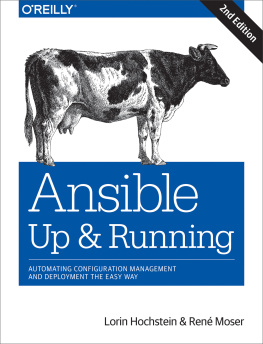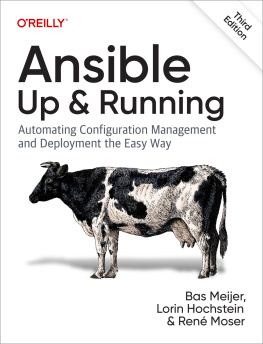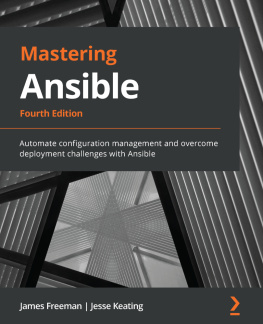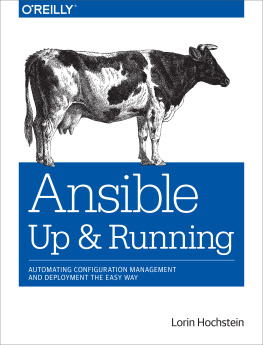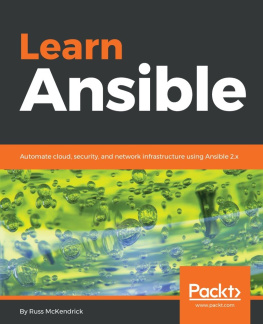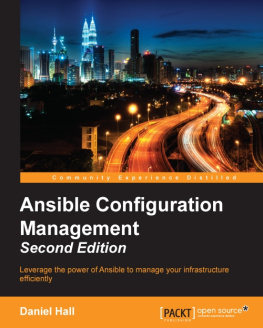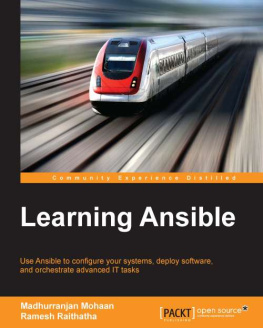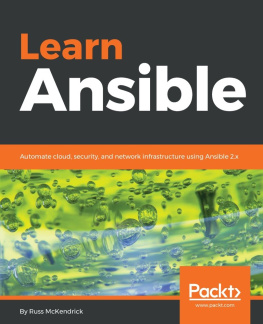Praise for Ansible: Up and Running
I devoured the manuscript for the first edition of Ansible: Up and Running within a few hours: Lorin did an amazing job describing all of Ansibles facets, and I was excited to hear hed joined forces with Ren for a second edition. In this, the two authors have done an outstanding job of showing us how to put an incredibly useful utility to good use, and I cannot think of anything they havent covered in depth.
Jan-Piet Mens, consultant
Impressive coverage of Ansible. Its not only great for getting started, but also for understanding how to use the more advanced features. Fantastic resource for leveling up your Ansible skills .
Matt Jaynes, Chief Engineer, High Velocity Ops
The nice thing about Ansible is that you can start by doing, and that it lends itself for easy prototyping, which is great to make quick progress and get things done. However, over time this tends to lead to gaps in knowledge and understanding, which is hard to come by .
Ansible: Up and Running is a very useful resource because it can fill those gaps, as it explains Ansible from the very basics up to the complexities of working with YAML and Jinja2. And because it is packed with many off-the-shelf examples to learn from and build on, it gives insight into how others are automating their environments.
During training sessions and hands-on missions over the past few years, I always recommend this book to colleagues and customers.
Dag Wieers, freelance Linux system engineer, long-time Ansible contributor and consultant
This book gives everyone an easy start, but also a deep dive into Ansible configuration management. There are a lot of hints and how-tos and it covers a wide range of use cases like AWS, Windows, and Docker.
Ingo Jochim, Manager Cloud Implementation, itelligence GMS/CIS
Lorin and Ren did an amazing job by writing this book. The authors take the user by the hand and lead him/her through all the important steps of creating and managing a properly designed Ansible project. The book is much more than a simple Ansible reference, as it covers several important conceptual topics missing from the official docs. It is an excellent resource for Ansible beginners, but it also includes many practical concepts and tricks for existing Ansiblers.
Dominique Barton, DevOps engineer at confirm IT solutions
Ansible: Up and Running
by Lorin Hochstein and Ren Moser
Copyright 2017 OReilly Media, Inc. All rights reserved.
Printed in the United States of America.
Published by OReilly Media, Inc. , 1005 Gravenstein Highway North, Sebastopol, CA 95472.
OReilly books may be purchased for educational, business, or sales promotional use. Online editions are also available for most titles (http://oreilly.com/safari). For more information, contact our corporate/institutional sales department: 800-998-9938 or corporate@oreilly.com .
- Editor: Brian Anderson
- Production Editor: Kristen Brown
- Copyeditor: Sharon Wilkey
- Proofreader: James Fraleigh
- Indexer: Ellen Troutman-Zaig
- Interior Designer: David Futato
- Cover Designer: Karen Montgomery
- Illustrator: Rebecca Demarest
- December 2014: First Edition
- August 2017: Second Edition
Revision History for the Second Edition
- 2017-07-20: First Release
The OReilly logo is a registered trademark of OReilly Media, Inc. Ansible: Up and Running, the cover image, and related trade dress are trademarks of OReilly Media, Inc.
While the publisher and the authors have used good faith efforts to ensure that the information and instructions contained in this work are accurate, the publisher and the authors disclaim all responsibility for errors or omissions, including without limitation responsibility for damages resulting from the use of or reliance on this work. Use of the information and instructions contained in this work is at your own risk. If any code samples or other technology this work contains or describes is subject to open source licenses or the intellectual property rights of others, it is your responsibility to ensure that your use thereof complies with such licenses and/or rights.
978-1-491-97980-8
[LSI]
Foreword
Ansible started as a simple side project in February of 2012, and its rapidgrowth has been a pleasant surprise. It is now the work product of about athousand people (and the ideas of many more than that), and it is widely deployed inalmost every country. Its not unusual in a computer meet-up to find a handful(at least) of people who use it .
Ansible is exciting perhaps because it really isnt. Ansible doesntattempt to break new ground, but rather to distill a lot of existing ideas that othersmart folks had already figured out and make them more accessible.
In creating Ansible, I sought a middle ground between somewhat computer-sciencey ITautomation approaches (themselves a reaction to tedious large commercialsuites) and hack-and-slash scripting that just gets things done. I also wondered, how canwe replace a configuration management system, a deployment project, anorchestration project, and our library of arbitrary but important shell scriptswith a single system? That was the idea.
Could we remove major architectural components from the IT automation stack?Eliminating management daemons and relying instead on OpenSSH meant thesystem could start managing a computer fleet immediately, without having to setup anything on the managed machines. Further, the system was apt to be morereliable and secure.
I had noticed that in trying to automate systems previously, things that shouldbe simple were often hard, and that writing automation content could oftencreate a time-sucking force that kept me from things I wanted to spend more timedoing. And I didnt want the system to require months to learn, either.
In particular, I personally enjoyed writing new software, but piloting automationsystems, a bit less. In short, I wanted to make automation quicker and leave more time for the things I cared about. Ansible was not something you weremeant to use all day long, but to get in, get out, and get back to doing thethings you care about. I hope you will like Ansible for many of the same reasons.
Although I spent a lot of time making sure Ansibles docs werecomprehensive, theres always a strong advantage to seeing material presented ina variety of ways, and often in seeing actual practice applied alongside thereference material. In Ansible: Up and Running, Lorin presents Ansible in a very idiomatic way, inexactly the right order in which you might wish to explore it. Lorin has beenaround Ansible since almost the very beginning, and Im grateful for hiscontributions and input.
Im also immensely thankful for everyone who has been a part of this project todate, and everyone who will be in the future. Enjoy the book, and enjoy managing your computer fleet! And remember to installcowsay!
Michael DeHaan
Creator of Ansible (software)
Former CTO of Ansible, Inc. (company)
April 2015
Preface to the Second Edition
In the time since the first edition of the book was written (back in 2014), there have beenbig changes in the world of Ansible. The Ansible project completed a majorrelease, hitting 2.0. Big changes happened outside the project as well:Ansible, Inc., the company that backs the Ansible project, was acquired by Red Hat.Red Hats acquisition hasnt slowed the Ansible project at all: its stillin active development and gaining users.
Weve made multiple changes in this edition. The most significantchange is the addition of five new chapters. The book now covers callback plugins, Windowshosts, network hardware, and Ansible Tower. We added so much content to theComplex Playbooks chapter that we expanded to a second chapter calledCustomizing Hosts, Runs and Handlers. We also rewrote the Docker chapterto cover the new Docker modules.

